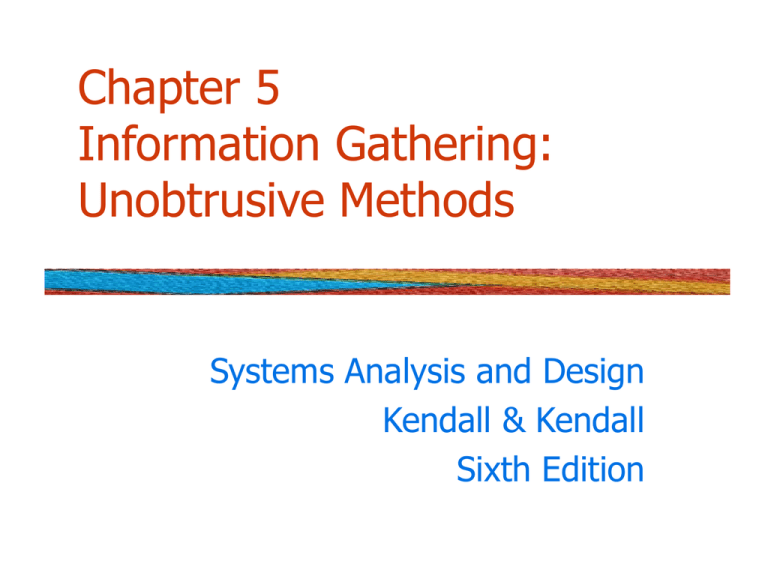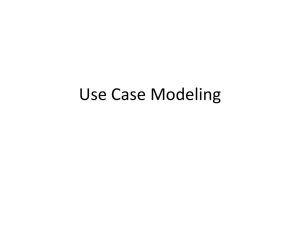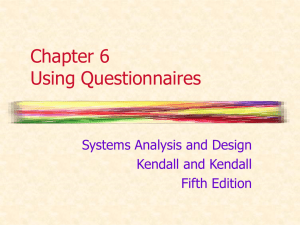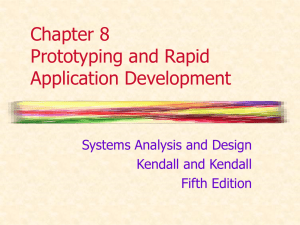
Chapter 5
Information Gathering:
Unobtrusive Methods
Systems Analysis and Design
Kendall & Kendall
Sixth Edition
Major Topics
• Sampling
• Quantitative document analysis
• Qualitative document analysis
• Observation
• STROBE
• Applying STROBE
Kendall & Kendall
© 2005 Pearson Prentice Hall
5-2
Sampling
• Sampling is a process of systematically
selecting representative elements of a
population.
• Involves two key decisions:
• Which of the key documents and Web sites
should be sampled.
• Which people should be interviewed or
sent questionnaires.
Kendall & Kendall
© 2005 Pearson Prentice Hall
5-3
Need for Sampling
The reasons systems analysts do
sampling are:
• Reducing costs.
• Speeding up the data-gathering process.
• Improving effectiveness.
• Reducing data-gathering bias.
Kendall & Kendall
© 2005 Pearson Prentice Hall
5-4
Sampling Design Steps
To design a good sample, a systems
analyst needs to follow four steps:
• Determining the data to be collected or
described.
• Determining the population to be sampled.
• Choosing the type of sample.
• Deciding on the sample size.
Kendall & Kendall
© 2005 Pearson Prentice Hall
5-5
Sample Size
The sample size decision should be
made according to the specific
conditions under which a systems
analysts works with such as:
• Sampling data on attributes.
• Sampling data on variables.
• Sampling qualitative data.
Kendall & Kendall
© 2005 Pearson Prentice Hall
5-6
Types of Sampling
• The four types of sampling are:
• Convenience.
• Purposive.
• Simple random.
• Complex random.
Kendall & Kendall
© 2005 Pearson Prentice Hall
5-7
Convenience Sampling
• Unrestricted, nonprobability samples
• Easy to arrange
• Most unreliable
Kendall & Kendall
© 2005 Pearson Prentice Hall
5-8
Purposive Sampling
• Based on judgment
• Analyst chooses group of individuals to
sample
• Based on criteria
• Nonprobability sample
• Moderately reliable
Kendall & Kendall
© 2005 Pearson Prentice Hall
5-9
Simple Random Sampling
• Based on a numbered list of the
population
• Each person or document has an equal
chance of being selected
Kendall & Kendall
© 2005 Pearson Prentice Hall
5-10
Complex Random Sampling
• The three forms are:
• Systematic sampling.
• Stratified sampling.
• Cluster sampling.
Kendall & Kendall
© 2005 Pearson Prentice Hall
5-11
Systematic Sampling
• Simplest method of probability sampling
• Choose every kth person on a list
• Not good if the list is ordered
Kendall & Kendall
© 2005 Pearson Prentice Hall
5-12
Stratified Sampling
Stratification is the process of :
• Identifying subpopulations or strata
• Selecting objects or people for sampling from
the subpopulation
• Compensating for a disproportionate number
of employees from a certain group
• Selecting different methods to collect data
from different subgroups.
• Most important to the systems analyst
Kendall & Kendall
© 2005 Pearson Prentice Hall
5-13
Cluster Sampling
• Select group of documents or people to
study.
• Select typical groups that represent the
remaining ones.
Kendall & Kendall
© 2005 Pearson Prentice Hall
5-14
Deciding Sample Size for
Attribute Data
Steps to determine sample size are:
• Determine the attribute to sample.
• Locate the database or reports where the
attribute is found.
• Examine the attribute and estimate p, the
proportion of the population having the
attribute.
Kendall & Kendall
© 2005 Pearson Prentice Hall
5-15
Deciding Sample Size for
Attribute Data
Steps to determine sample size (continued)
• Make the subjective decision regarding the
acceptable interval estimate, i
• Choose the confidence level and look up the
confidence coefficient (z value) in a table
• Calculate σp, the standard error of the proportion
as follows:
i
σp =
z
Kendall & Kendall
© 2005 Pearson Prentice Hall
5-16
Deciding Sample Size for
Attribute Data
Steps to determine sample size (continued)
• Determine the necessary sample size, n,
using thep(1-p)
following formula:
n=
Kendall & Kendall
σp
2
+1
© 2005 Pearson Prentice Hall
5-17
Confidence Level Table
2.58
2.33
2.17
2.05
1.96
1.65
1.28
.67
99%
98%
97%
96%
95%
90%
80%
50%
Kendall & Kendall
© 2005 Pearson Prentice Hall
5-18
Hard Data
In addition to sampling, investigation of
hard data is another effective method
for systems analysts to gather
information.
Kendall & Kendall
© 2005 Pearson Prentice Hall
5-19
Obtaining Hard Data
Hard data can be obtained by:
• Analyzing quantitative documents such as
records used for decision making.
• Performance reports.
• Records.
• Data capture forms.
• Ecommerce and other transactions.
Kendall & Kendall
© 2005 Pearson Prentice Hall
5-20
Qualitative Documents
Examine qualitative documents for the
following:
• Key or guiding metaphors.
• Insiders vs. outsiders mentality.
• What is considered good vs. evil.
• Graphics, logos, and icons in common
areas or Web pages.
• A sense of humor.
Kendall & Kendall
© 2005 Pearson Prentice Hall
5-21
Analyzing Qualitative
Documents
Qualitative documents include:
• Memos.
• Signs on bulletin boards.
• Corporate Web sites.
• Manuals.
• Policy handbooks.
Kendall & Kendall
© 2005 Pearson Prentice Hall
5-22
Observation
• Observation provides insight on what
organizational members actually do.
• See firsthand the relationships that exist
between decision makers and other
organizational members.
Kendall & Kendall
© 2005 Pearson Prentice Hall
5-23
Analyst’s Playscript
• Involves observing the decision-makers
behavior and recording their actions
using a series of action verbs
• Examples:
• Talking.
• Sampling.
• Corresponding.
• Deciding.
Kendall & Kendall
© 2005 Pearson Prentice Hall
5-24
STROBE
STRuctured OBservation of the
Environment-- a technique for
observing the decision maker's
environment
Kendall & Kendall
© 2005 Pearson Prentice Hall
5-25
STROBE Elements
Analyzes seven environmental elements:
• Office location.
• Desk placement.
• Stationary equipment.
• Props.
• External information sources.
• Office lighting and color.
• Clothing worn by decision makers.
Kendall & Kendall
© 2005 Pearson Prentice Hall
5-26
Office Location
• Accessible offices
• Main corridors, open door
• Major traffic flow area
• Increase interaction frequency and informal
messages
• Inaccessible offices
• May view the organization differently
• Drift apart from others in objectives
Kendall & Kendall
© 2005 Pearson Prentice Hall
5-27
Desk Placement
• Visitors in a tight space, back to wall,
large expanse behind desk
• Indicates maximum power position
• Desk facing the wall, chair at side
• Encourages participation
• Equal exchanges
Kendall & Kendall
© 2005 Pearson Prentice Hall
5-28
Stationary Office Equipment
File cabinets and bookshelves:
• If not present, person stores few
items of information personally.
• If an abundance, person stores
and values information.
Kendall & Kendall
© 2005 Pearson Prentice Hall
5-29
Props
• Calculators
• Personal computers
• Pens, pencils, and rulers
• If present, person processes data
personally
Kendall & Kendall
© 2005 Pearson Prentice Hall
5-30
External Information Sources
• Trade journals or newspapers indicate
the person values outside information.
• Company reports, memos, policy
handbooks indicate the person values
internal information.
Kendall & Kendall
© 2005 Pearson Prentice Hall
5-31
Office Lighting and Color
• Warm, incandescent lighting indicates:
• A tendency toward more personal
communication.
• More informal communication.
• Brightly lit, bright colors indicate:
• More formal communications (memos,
reports).
Kendall & Kendall
© 2005 Pearson Prentice Hall
5-32
Clothing
• Male
• Formal two piece suit - maximum authority
• Casual dressing (sport jacket/slacks) more participative decision making
• Female
• Skirted suit - maximum authority
Kendall & Kendall
© 2005 Pearson Prentice Hall
5-33
Anecdotal List with Symbols
•
The five symbols used to evaluate how
observation of the elements of STROBE
compared with interview results are:
• A checkmark, the narrative is confirmed.
• An “X” means the narrative is reversed.
• An oval or eye-shaped symbol serves as a cue to
•
•
Kendall & Kendall
look further.
A square means observation modifies the
narrative.
A circle means narrative is supplemented by
observation.
© 2005 Pearson Prentice Hall
5-34








